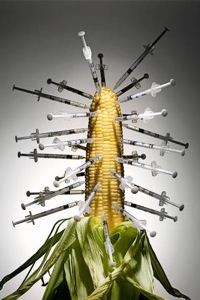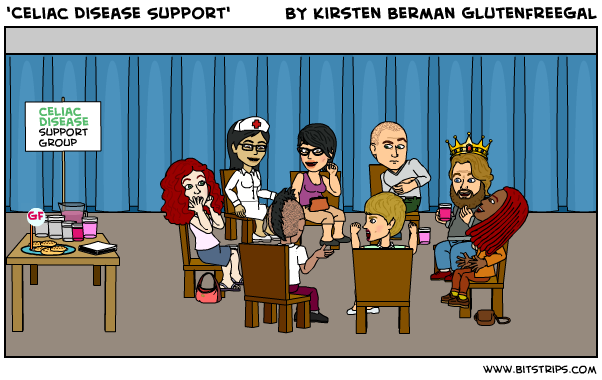This is a great article from Caitlin Shetterly in Elle Magazine about GMO corn and how pervasive it has actually become in our daily lives. She discusses her own allergy w/GMO corn and the years of problems she faced with misdiagnosis after misdiagnosis. Luckily, she found one amazing doctor who could finally help. Here’s a snippet of her story, I highly suggest reading the whole article, it is quite enlightening… as are some of the responses and comments people left regarding the article.

The Bad Seed: The Health Risks of Genetically Modified Corn
The office of allergist Paris Mansmann, MD, sits on a grassy slope overlooking the Royal River, a wide waterway that originates in inland Maine and winds down across farmland and under train tracks until it hits the coastal town of Yarmouth, where it sloshes into the Atlantic Ocean. When I first came to Mansmann in February 2011, the river was covered with ice, and bare trees stood silver sentry on its shores. I was 36. I’d been sick for three and a half years.
During that time, when I wasn’t working as a writer and theater director or being a wife and mother, I visited doctors and had tests. I told few friends or members of my extended family how ill I was, because I didn’t have any way to explain what was wrong. I had no diagnosis, just a collection of weird symptoms: tight, achy pain that radiated through my body and caused me to hobble around (my ankles, I’d joke to my husband, Dan, felt like they’d been “Kathy Batesed,” à la the movie Misery); burning rashes that splashed across my cheeks and around my mouth like pizza sauce; exhaustion; headaches; hands that froze into claws while I slept and hurt to uncurl in the morning; a constant head cold; nausea; and, on top of all that, severe insomnia—my body just could not, would not, turn off and rest.
I visited every doctor who’d see me and tried everything they threw at me: antidepressants; painkillers; elimination diets (including a long eight months when I went without any of the major allergens, such as gluten, nuts, dairy, soy, and nightshades); herbal supplements; iodine pills; steroid shots; hormone treatments; Chinese teas; acupuncture; energy healing; a meditation class—you name it, I did it. Nothing worked. After I maxed out the available rheumatologists, endocrinologists, nutritionists, gastroenterologists, Lyme disease specialists, acupuncturists, and alternative-medicine practitioners in the Portland metropolitan area, I was sent to neurologists in Boston. All of my tests came back normal.
In late 2010, after a long and unhappy antibiotic treatment for Lyme disease, my newest GP (who’s still my doctor today), Chuck de Sieyes, MD, announced that he was referring me to Mansmann: “Because I have no idea what’s going on with you, and he’s one of the smartest guys around. And frankly, I’ve had it!”
Mansmann had moved to Yarmouth with his wife and kids to be close to his parents, who’d retired in Maine. A third-generation allergist, he worked in his father’s allergy clinic, at Jefferson Medical College in Philadelphia, during high school. While in college at Saint Joseph’s University, also in Philadelphia, he helped his dad develop two asthma drugs. Later, he headed an allergy and immunology clinic at a West Virginia hospital for 10 years.
Can GMO Corn be the Problem?
Mansmann has a helmet of thick, graying hair and an intensely serious air. After escorting me into an exam room, he sat down across from me and promptly pushed aside my thick medical file. He’d read through it all, he said, but he wanted to hear the story from me. He listened patiently, asking questions every so often: When did my rashes flare? Was the pain an ache in my muscles, or did it feel deeper? Was I worse after I slept or at the end of the day? He seemed, as we spoke, to have all the time in the world. Then, with no pyrotechnics, he offered his theory: “I think it’s possible you’ve developed a reaction to genetically modified corn.”
Genetically modified corn? Everyone’s heard of GMO corn, but I realized I didn’t know what it actually was. Mansmann explained that starting in the mid-1980s, the biotechnology giant Monsanto began to genetically alter corn to withstand its herbicide Roundup—the goal being to eradicate weeds but not crops—as well as to resist a pest called the corn borer. These small changes in the DNA of the corn are expressed by the plant as proteins. It’s those proteins, Mansmann believes, that can act as allergens, provoking a multisystemic disorder marked by the overproduction of a type of white blood cell called an eosinophil.
He swabbed inside my nose with a Q-tip, then placed the results under a microscope. “Take a look,” Mansmann said. “See all those pink cells? Those are eosinophils.” My nose, it seemed, was chock-full of them. When the immune system is working properly, eosinophils swarm certain invading substances, be they parasites or viruses, and work to eliminate them. Sometimes, however, an allergenic protein may prompt the immune system to release eosinophils. Then, it’s as if a faucet gets turned on but can’t be turned off—eosinophils just keep coming. Eventually they begin to leave the bloodstream and may infiltrate and damage the GI tract, esophagus, mucous membranes, lungs, the fascial system (the layer of connective tissue that surrounds the muscles, blood vessels, and nerves), and the skin—hence, the avalanche of symptoms. (Some allergists say that the best way to test for a true eosinophilic disorder is to look for the cells in the esophagus and GI tract with an endoscopy. But Mansmann thinks that once you have a preponderance of them in your nasal mucus, they’re likely to be elsewhere.)
No More Corn Products
Mansmann’s advice was to strip all corn, even that marked organic, from my diet. “It’s almost impossible to find a corn source in the United States that doesn’t have the [protein] in it,” he said. The U.S. government started approving GMO corn and soybeans for sale in the mid-1990s, and today, 88 percent of corn, and 93 percent of soybeans, are the transgenic varieties. Moreover, Mansmann and others contend that due to cross-pollination via winds, birds, and bees, there’s no such thing anymore as a GMO-free corn crop. He estimated that it would take from two to four months of living without corn for the eosinophils to cycle out of my body, and almost a year before I’d feel entirely like myself.
While I quickly discovered that blaming GMO foods for any kind of health problem is controversial in the medical and biotech worlds, what’s beyond debate is the increase in the incidence of autoimmune disorders such as type 1 diabetes, lupus, and celiac disease, as well as of allergies. As for the latter, the National Health Interview Survey found, for instance, that since 1999, the number of children with food allergies has jumped by 50 percent, and those with skin allergies by 69 percent (and the increase isn’t merely a by-product of fuller reporting by parents, experts say).
Allergenic eosinophilic disorders, however, aren’t counted in that data. They were first identified about 20 years ago, according to a pioneer in the field, Marc Rothenberg, MD, PhD, a professor at University of Cincinnati medical school and director of an affiliated center for eosinophilic disorders. “We’re in the midst of an allergy and autoimmune epidemic,” Rothenberg told me on the phone, “and the environment is the black box.” Mansmann’s GMO theory was “interesting,” he went on, before quickly adding that “no one in conventional medicine will have the data” to prove it.
Corn is in Everything
Back in 2011, though, I was desperate enough that I was willing to try the diet Mansmann recommended. After all, how hard could it be to give up corn? The answer was: way harder than I imagined. Corn was my Waldo, popping up everywhere: in tea bags, juice, and cheese culture; it lined my “to go” coffee cups and plastic bags of frozen vegetables; it coated my store-bought apples and was on the bottom of restaurant pizza—almost everything my family used, no matter how piously natural and organic, had corn in it. It came under the guise of dozens of names like “xanthan gum,” “natural flavors,” “free-flowing agents,” “vitamin E,” “ascorbic acid,” “citric acid,” and “cellulose,” to name a few. Almost daily, I’d find a new culprit. “Damn, this toothpaste is full of corn!” Then: “Wait, our dish soap is made from corn!” Or: “Oh my God, iodized salt has dextrose in it!”
Not to mention the corn that is fed to animals whose meat and eggs I ate, whose milk I drank. I had to restrict my diet, Mansmann said, to vegetables, grains other than corn, grass-fed beef and dairy, wild fish, and game (if I was game). My husband and I threw ourselves into the corn-free diet with gusto: We began baking all our bread, we learned how to make our own flour tortillas and sweet treats like muffins and cakes. By luck, we met an intrepid farmer raising corn-free chickens (harder than you might guess, because chickens have literally been bred to get fat fast on corn). We eschewed anything premade and began gathering foods from local sources we could trust. I stopped taking every medicine or supplement with corn in it (which was most of them). Wherever I went, I took my own stainless-steel coffee cup.
The first thing I noticed was that my skin rashes began to dissipate. Then, slowly, my body stopped aching, and I could walk or even jog easily, for the first time in years. I started to have more energy, and I slept better at night. The head cold went away—poof—and I wasn’t going through a box of tissues a day. My hands became less stiff. I realized, in retrospect, that my frozen hands had been the hardest symptom to tolerate: I could barely button my son’s small shirts or apply a Band-Aid, which made me feel useless as a mother. Almost four months later, in late May, I felt pretty much like my old self. I was so startled by my physical well-being that I didn’t know how to enjoy it. Each night I’d go to bed preparing myself for the possibility that I might wake up sick again the next morning. Could GMO corn really be my problem? Could this blessed state really last? I couldn’t let go; I had to know more. I decided to visit Rothenberg and his team of researchers endeavoring to crack open the black box.”


















